Q3 GDP has been revised to 2.0%. This is a smidgen, a 0.1 percentage point lowering than the last estimate. Most factors which make up GDP did not change much from the primarily estimate. Changes in private inventories was where the revision occurred as they were revised from -0.59 to -0.71 percentage points of GDP. Consumer spending and domestic demand are still muddling along with moderate growth. The trade deficit subtracted over -0.36 GDP percentage points . Local and State governments contributed a small amount of growth to GDP. Investment in equipment added 0.57 percentage points to GDP.

As a reminder, GDP is made up of: where Y=GDP, C=Consumption, I=Investment, G=Government Spending, (X-M)=Net Exports, X=Exports, M=Imports*. GDP in this overview, unless explicitly stated otherwise, refers to real GDP. Real GDP is in chained 2009 dollars.
The below table shows the GDP component comparison in percentage point spread from Q3 to Q2.
| Comparison of Q3 2015 and Q2 2015 GDP Components | |||
|---|---|---|---|
|
Component |
Q3 2015 |
Q2 2015 |
Spread |
| GDP | +1.99 | +3.91 | -1.92 |
| C | +2.04 | +2.42 | -0.38 |
| I | –0.11 | +0.85 | -0.96 |
| G | +0.32 | +0.46 | -0.14 |
| X | +0.09 | +0.64 | -0.55 |
| M | -0.35 | –0.46 | +0.11 |
Consumer spending, C was fairly healthy with a 2.04 percentage point GDP contribution. Below is a percentage change graph in real consumer spending going back to 2000.
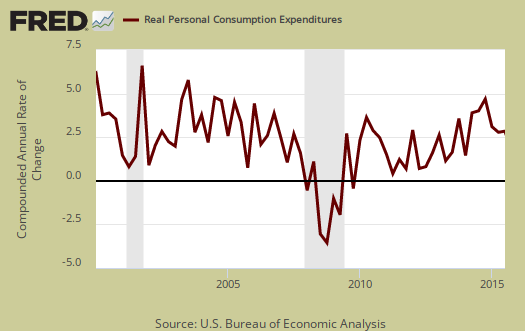
Goods contributed 1.08 percentage points to GDP and within goods, durables was 0.47 percentage points. Services was a 0.96 percentage point contribution, a significant revision downward from the advance report. Graphed below is PCE with the quarterly annualized percentage change breakdown of durable goods (red or bright red), nondurable goods (blue) versus services (maroon).

Imports and Exports, M & X were a -0.26 percent point contribution. Trade activity remains at similar levels to Q2.

Government spending, G contributed 0.32 percentage points to Q3 GDP with almost all of it, 0.30 percentage points, contributed by state and local governments spending and investment.

Investment, I is made up of fixed investment and changes to private inventories. The change in private inventories alone was a -0.71 percentage point contribution. While revised downward from the primarily estimate, the advance Q3 GDP estimate was much worse, with a horrific -1.44 percentage point contribution. Below are the change in real private inventories and the next graph is the change in that value from the previous quarter.

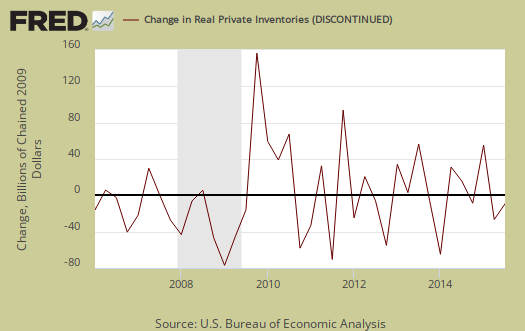
Fixed investment is residential and nonresidential and was 0.60 percentage points of GDP contribution. Nonresidential was a 0.33 individual percentage point contribution.
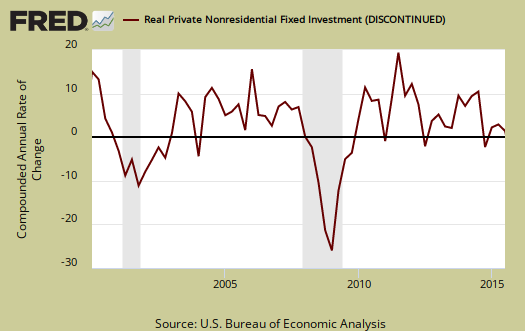
Residential fixed investment was 0.27 percentage points to GDP. The below graph shows residential fixed investment.
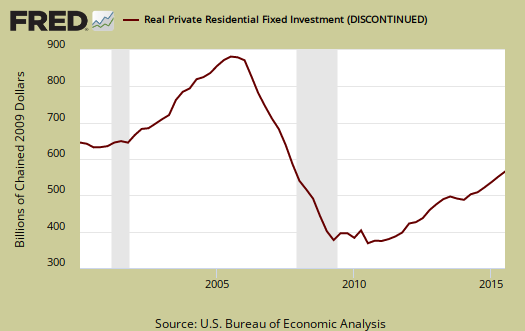
Nominal GDP: In current dollars, not adjusted for prices, of the U.S. output,was $18,060.2 billion, a 3.3% annualized increase for Q3 from Q2. In Q2, current dollar GDP increased 6.1%.

Real final sales of domestic product is GDP - inventories change. This figures gives a feel for real demand in the economy. This is because while private inventories represent economic activity, the stuff is sitting on the shelf, it's not demanded or sold. Real final sales increased 2.7%.

Gross domestic purchases are what U.S. consumers bought no matter whether it was made in Ohio or China. It's defined as GDP plus imports and minus exports or using our above equation: where P = Real gross domestic purchases. Real gross domestic purchases increased 2.2% in Q3. Exports are subtracted off because they are not available for purchase by Americans, but imports are available for purchase in the U.S. When gross domestic purchases exceed GDP, that's actually bad news, it means America is buying imports instead of goods made domestically. Q2 gross domestic purchases increased 3.6%.

The price index for gross domestic purchases increased 1.3% for Q3. Without food and energy considered, the core price index increased 1.3%. This is below the Federal Reserve's target inflation rate, so somewhat surprising interest rates were raised. Below is the price index for gross domestic purchases.
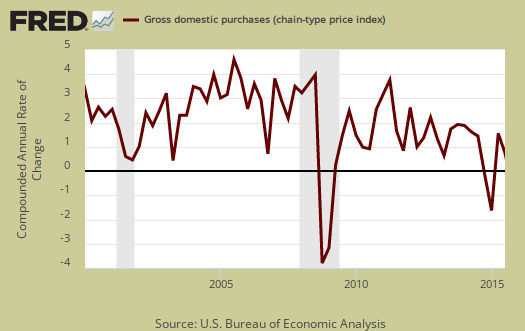
GNP - Gross National Product: Real gross national product, GNP, is the goods and services produced by the labor and property supplied by U.S. residents.
GNP = GDP + (Income receipts from the rest of the world) - (Income payments to the rest of the world)
Real GNP increased 1.3% for Q3. In Q2 GNP increased 3.9%. GNP includes, whereas GDP excludes, net income from the rest of the world. GNP increases beyond GDP if Americans made out like bandits from foreign investments more than foreigners cashed in on investments within the U.S. borders.

GDI - Gross Domestic Income: Gross Domestic Income is all income from within the borders of a nation and should normally equal GDP. GDI is wages, profits & taxes minus subsidies. Real GDI was 2.7% in Q3. Q2 GDI was a 2.2% increase. The BEA says GDI measures the economic output as the costs incurred as well as incomes earned in the production of GDP. The BEA also states GDI can have statistical discrepancy over short time periods.
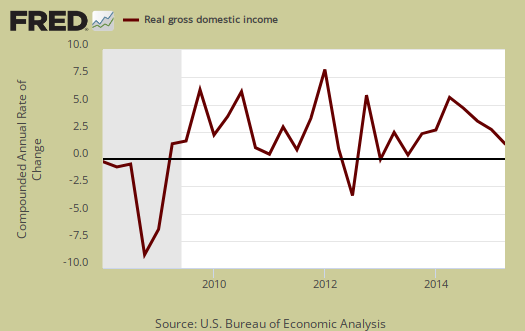
Below are the percentage changes of the Q3 2015 GDP components, from Q2. The thing to notice is how exports improved for Q2. There is a difference between percentage change and percentage point change. Point change adds up to the total GDP percentage change and is reported above. The below is the individual quarterly percentage change, against themselves, of each component which makes up overall GDP. Additionally these changes are seasonally adjusted and reported by the BEA in annualized format.
|
Q3 2015 GDP Component Percentage Change (annualized) |
|||
|---|---|---|---|
| Component | Percentage Change from Q2 | ||
| GDP | +2.0% | ||
| C | +3.0% | ||
| I | -0.7% | ||
| G | +1.8% | ||
| X | +0.7% | ||
| M | +2.3% | ||
Overall this GDP report implies some bad news with contracting inventories in terms of economic growth. Contracting inventories implies businesses are not expecting a surge of new business. Yet consumer spending was on par with last quarter and other GDP elements stood out as steady as she goes components. Equipment investment and an OK showing by residential investment. Trade seems to be at the same levels with very little growth as less oil imports and currency manipulation take their toll. In a nutshell, it's so-so economic growth and nothing to write home about.
Other overviews on gross domestic product can be found here. The BEA GDP site is here.

After all is said and done...
After all the revisions, what do you guess GDP will be for FY2015?
THE GUARDIAN: "US third-quarter GDP revised down to 2%, down from previous estimate and a marked slowdown from previous quarter’s 3.9%"
http://www.theguardian.com/business/2015/dec/22/us-economy-third-quarter...
December 23, 2015
Q3 GDP 2.0% as Investment in Inventories Declined
http://www.economicpopulist.org/content/q3-gdp-20-investment-inventories...
November 29, 2015
On the Revision of 3rd Quarter GDP from a 1.5% Growth Rate to a 2.1% Rate
http://www.economicpopulist.org/content/revision-3rd-quarter-gdp-15-grow...
October 30, 2015
Q3 GDP A Not So Hot 1.5%
http://www.economicpopulist.org/content/q3-gdp-not-so-hot-15-5863
September 26, 2015
Q2 GDP Revised Even Higher to 3.9%
http://www.economicpopulist.org/content/q2-gdp-revised-even-higher-39-5847
August 27, 2015
Q2 GDP Soars With 3.7% Growth
http://www.economicpopulist.org/content/q2-gdp-soars-37-growth-5831
always revised
Probably the worst "revisions" was when they claimed IP is actually economic growth and changed the way NIPA are tabulated. But in terms of generic revisions, it's always this way. Very difficult to be precise with so many inputs, such a large and diverse economy.